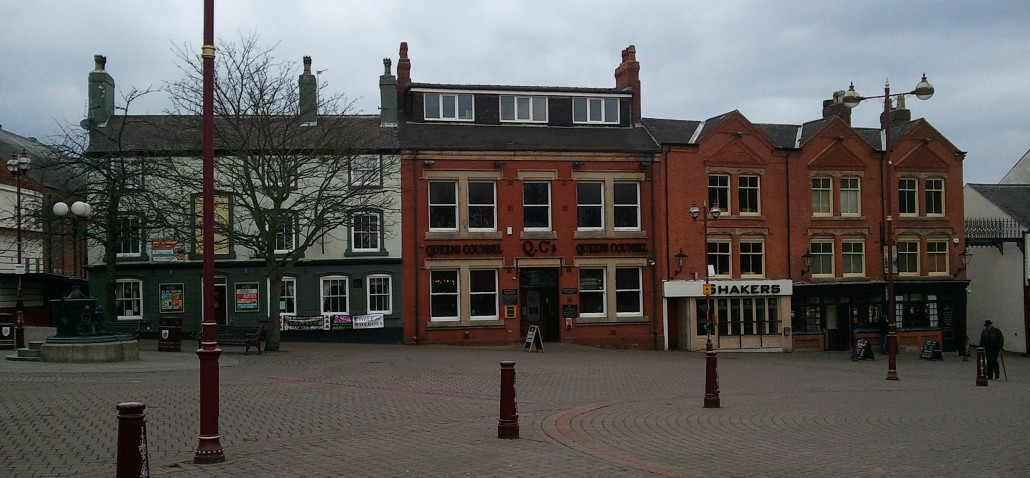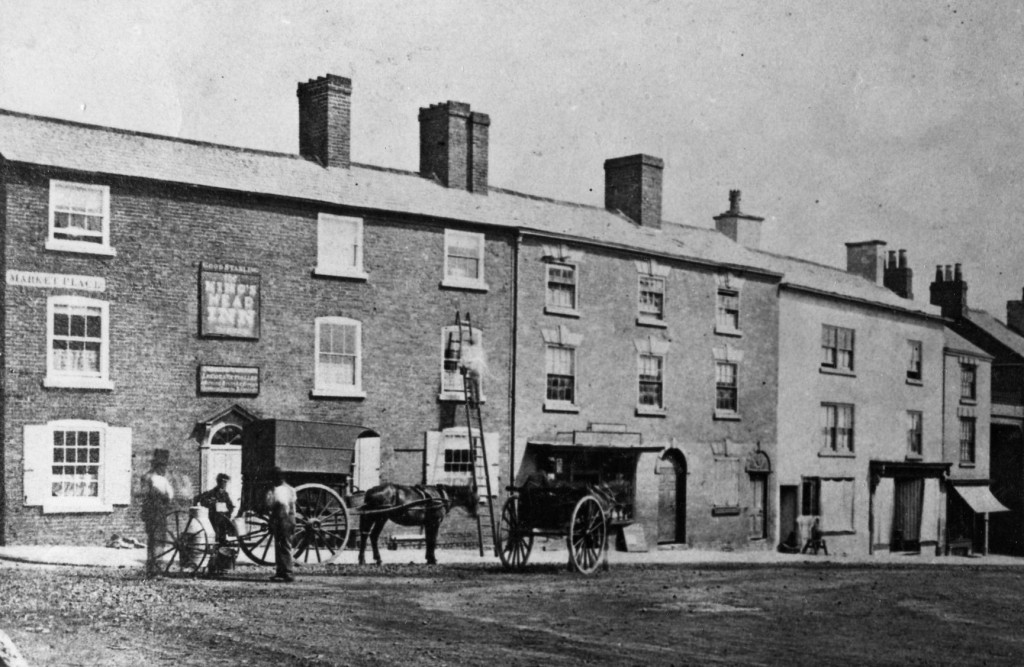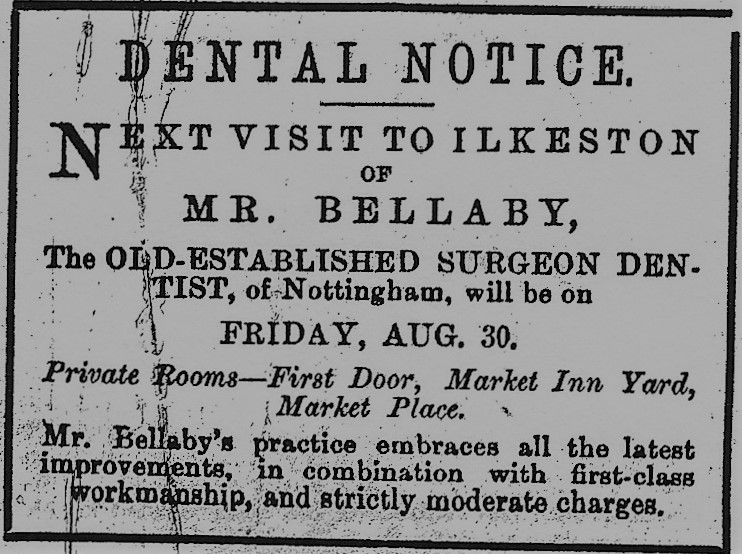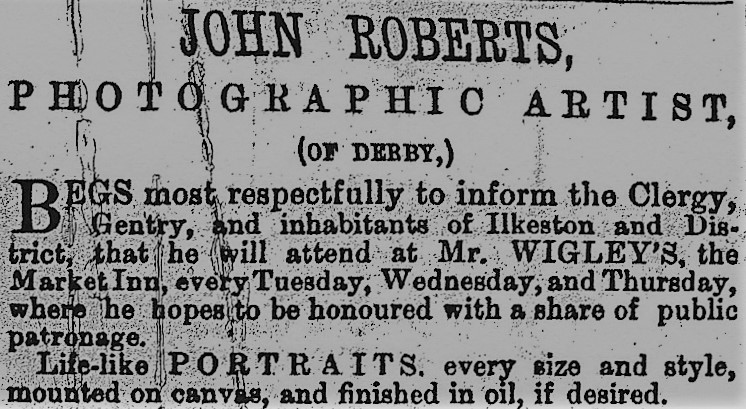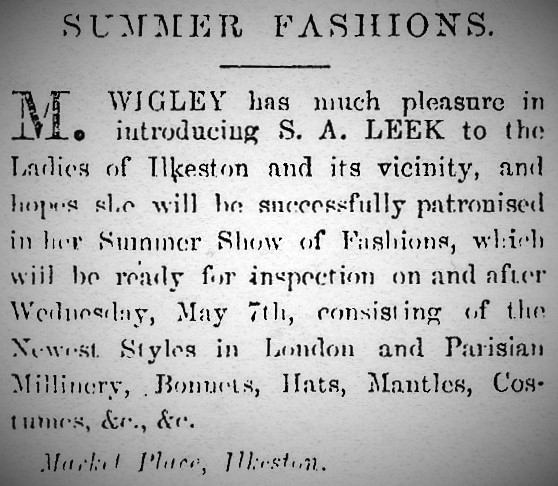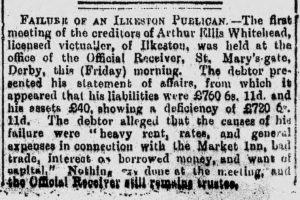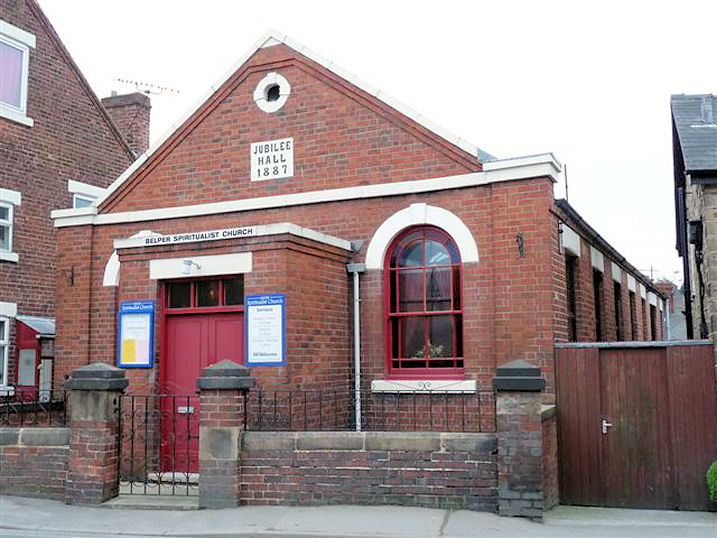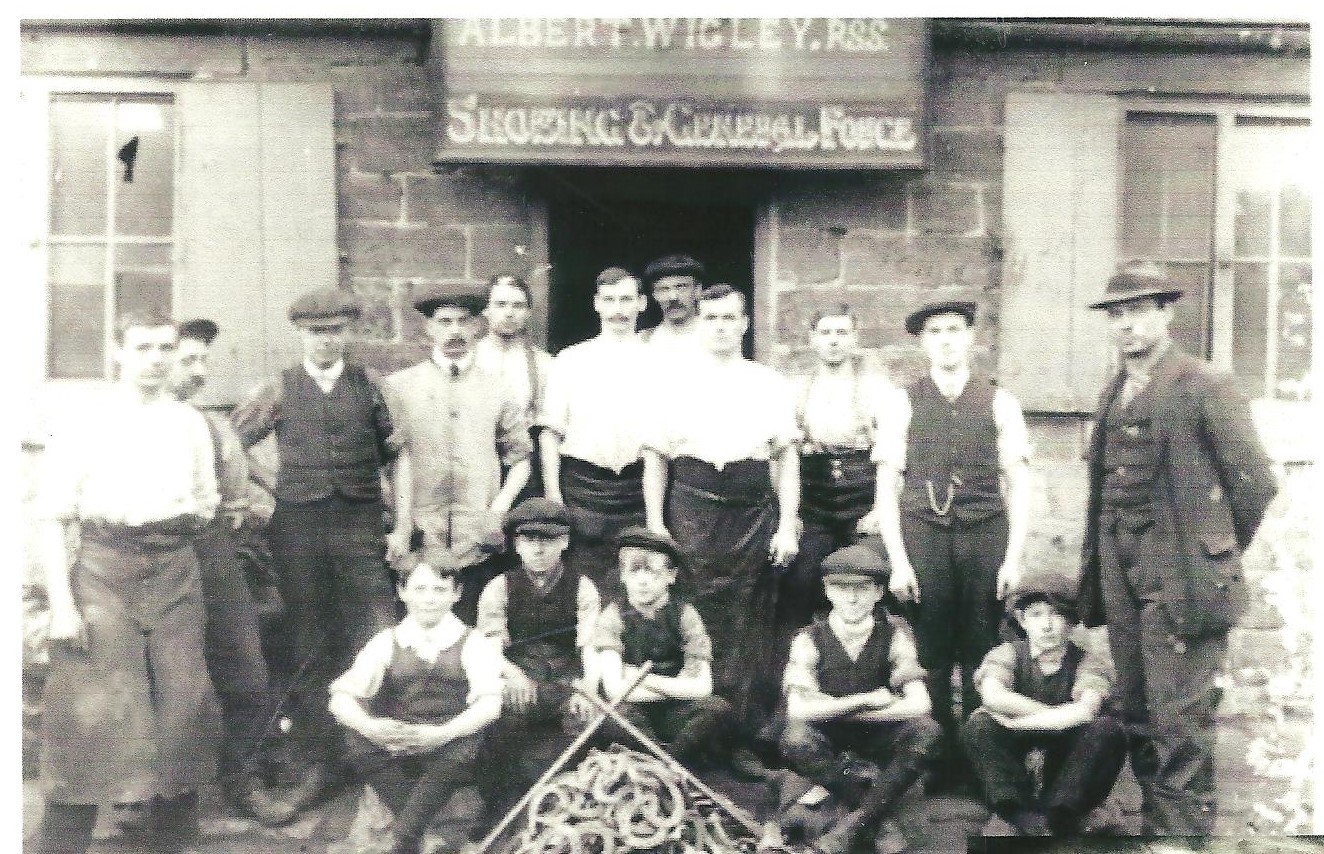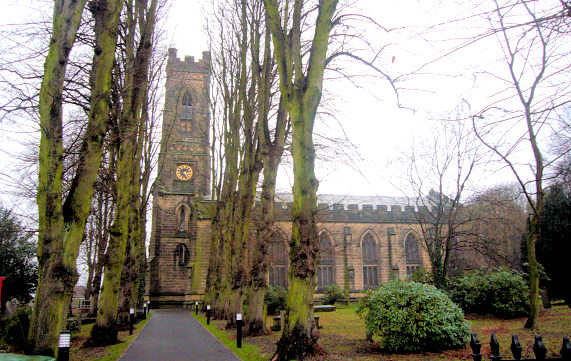Now and then …..
Leaving behind Mr. and Mrs. Childs, we see …..
The north side of the Market Place from the King’s Head (5 Market Place) to the Market Inn (8 Market Place) in the late 1870’s. (courtesy of Ilkeston Library)
In the photograph immediately above, we see the properties from Pimlico (left) to the passageway leading to the rear of these properties (extreme right) — today (2021) this is the side of the upper Market Place from the King’s Head Inn to the Market Tavern. In 1800 neither of these two establishments existed. On this site stood a grocer’s shop and a row of three cottages, all owned by draper/grocer Thomas Harrison (1770-1816). He had inherited these from his father, Thomas senior (1744-1790) and he lived in the shop there. When he died the business passed to his son, Thomas (1792-1874?) … the latter traded there until leaving the town in the 1830s, eventually to settle in Birmingham.
Note that Ilkeston did have a King’s Head Inn at this time, but it was on the far side of the lower Market Place.
——————————————————————————————————————————————–
Jerry Wigley
Adeline recalls the landlord …. “Jedediah Wigley, known as Jerry Wigley, built two shops, and also the Market Tavern (on the north side of the Market Place). He was the landlord of the Market Tavern.
“One shop was empty for a long time until taken by Mr. John Wombell, stationer, of Bath Street. The second shop was used by Jerry’s daughter Sophia for a millinery and dressmaking business.”
At another point Adeline records that “his two daughters carried on a Millinery and Dressmaking business.”
The Market Inn was at 8 Market Place on the 1871 and 1881 censuses. After the 1887 renumbering, it was number 11
Jedediah Wigley, born in Belper, was the son of shoemaker John and Elizabeth (nee Kiddy), and brother of builder Robert of Albion Place. There is evidence that in 1809 his father was convicted of forging banknotes and was transported to Sydney, Australia, then north to Newcastle, and finally to Parramatta. In the meantime Elizabeth and children were removed from Belper to Heage. (In 1820 John married Elizabeth Jones in Parramatta.)(** see the footnote at the bottom of the page)
What’s occurring here ??
Notice in the newspaper declaration (below) that Moses Mason was the Parish Constable in 1833 before George Small took over; George was his Headborough or deputy constable at that time. Notice too that Jedediah was a bricklayer.
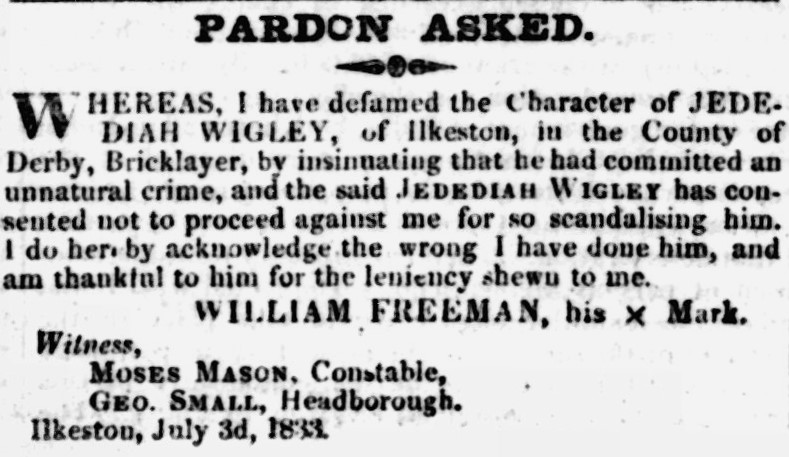 Nottingham Review and General Advertiser (July 12th, 1833)
Nottingham Review and General Advertiser (July 12th, 1833)
In 1841 Jedediah was still a builder living in Burr Lane with his wife, Ruth (nee Ottewell), daughter of John and Mary (nee Martin), and his daughters Elizabeth, Mary, Martha and Sophia. In that year he bought a piece of land in the Market Place from Mapperley farmer Joseph Fletcher, soon after demolished the existing buildings there, and then built two new premises with adjacent stables, cart shed, brew houses and other outbuildings.
The Market Inn beerhouse was in the rear of one of the two buildings, its entrance facing into the alley at the side.
Jerry’s daughters Elizabeth and Martha used the frontage for their dressmaking and millinery shop. They were ready to supply an extensive variety of ’Leghorn, Tuscan, Millinery, Sewn chip and fancy bonnets, of the newest and most prevailing shapes’as well as ‘Mantles, Flowers, Feathers and Ribbons’.(IP.1853)
Builders Jedediah and brother Robert were in a partnership but this was dissolved at the beginning of 1843 (January 28th). Jedediah was at pains to point out to his numerous Friends in Ilkeston that he would continue to offer his services as a builder … in a superior style and at very reasonable rates. (DM)
And wouldn’t you just know it !!
You wait 30 years for one to arrive and then three come along at once!!
In August 1858 Jedediah was granted a licence to trade as a victualler. At the same time a similar licence was granted to Matthew Fletcher at The Havelock Tavern in Stanton Road and Samuel Lowe at the Needlemakers’ Arms in Kensington.
Quite an event for Ilkeston!!
These were the first victualler’s licences to be granted in the town for about three decades.
In 1863 Jedediah lost a crop of turnips which he had been cultivating in his garden….half of them were stolen while the rest were cut in two. The nearby garden of John Wombell was also visited by a midnight harvester who made off with all his lettuce and white cabbage, while about a dozen red cabbages were wantonly vandalised.
Shortly before this, similar attacks had been made on gardens in the Lawn and in Market Street.
Jerry’s daughters
In July 1864 eldest child Elizabeth Wigley married John Ball, eldest child of Francis and Mary (nee Hirst) and thus joined him to live at 42 Upper Talbot Street in Nottingham.
She died in that city in November 1912, aged 88.
She and John are buried together in Stanton Road Cemetery.
In 1868 daughter Sophia joined her sister Martha to continue the millinery business.
The other daughter, Mary, had married Eliezer Paling, starch manufacturer of Newark, on June 15th 1853 and for a time left Ilkeston.
Then in October 1869 Eliezer’s starch and flour works in Albert Street, Newark, all the adjoining and connected premises, and all the trade’s machinery and implements were put up for auction at the Woolpack Inn in Stodman Street…. an auction conducted by his younger brother Frederick. (In January 1870, at a different venue and with a different auctioneer, the premises were again up for auction).
Mary had not left the tavern trade however as she and her husband eventually settled at the same Woolpack Inn.
Across the alley from these premises was Jedediah’s second building – 9 Market Place — which was sold to William Marshall, baker, and above which was a printer’s workshop occupied from early 1859 by John Wombell of the Pioneer.
“Mr. Bourne, who had married one of Jerry’s daughters, followed Mrs. Wombell. He started in business as a bookseller and stationer.”
Shortly John Wombell moved a few doors away, into the premises of Woolstan Marshall, leaving Charles Henry Bourne, master printer, to move into the upstairs workshop.
Perhaps his proximity to the Wigley family had some effect on Charles Henry. In June 1873 he married Sophia Wigley and moved into the Market Inn to take over from Jedediah in November of that year, though the licence was transferred in the following month.
And Martha continued the Millinery trade without her sisters.
From the Ilkeston Pioneer May 1st 1873
————————————————————————————————————————————————-
The Market Inn for sale.
When Jedediah relinquished the Market Inn to his son-in-law Charles Henry Bourne in the summer of 1873, he did not retire from business. He commenced the sinking of a new colliery at the lower end of East Street, and this was not the only one in the Ilkeston area — encouraged by the recent rise in the price of coal. A new one was being sunk at Cotmanhay Wood, a new shaft had appeared on the land of Matthew Hobson in Stanton Road, and the Oakwell Colliery Company was expanding on its Derby Road site.
In May 1876 Jedediah lost his place on the Local Board through non-attendance, but by that time it was probably of little concern to him.
He died of acute bronchitis in November 1876, “suddenly as he was sitting by his fire in his own house in the Market Place”. He was 78 years old.
Two years later and after his widow Ruth had died at the same house, the Market Inn was put up for sale.
It comprised of a bar, tap-room, large club-room, parlour, capital front room suitable for vaults, upstairs sitting-room, four bedrooms, kitchen, with a brew house, washhouse, stabling, cow and cart sheds, and a large garden.
At the auction up to £3400 was bid but this did not meet the reserve and the Inn remained unsold. Offered at the same auction and also unsold were the adjacent milliner’s and printer’s and stationer’s shops and the printing office to the rear, and Charles Henry Bourne continued there for several years.
Eventually the Inn was sold to Ripley Old Brewery Co.
In August of 1878 the inn was up ‘to let’ with the shop at its front up for let in the following September. If you were interested in applying for the tenancy then full particulars could be supplied by the Ripley Old Brewery Co. Ltd.
At that time Charles Henry Bourne was still the inn’s landlord. The tool-shed in his back yard was serving as temporary home for six cases of ginger beer when a servant at the inn noticed late one evening that seven bottles were missing from the cases. About the same time a police sergeant on his beat in the area heard the sound of breaking glass coming from the inn yard and both these witnesses spotted possible culprits running away from the area. Suspicion quickly fell on two Pimlico lads, 12 year-old Barnabas Webster, son on Barnabas senior and Rebecca (nee Stanley), and Thomas Quinn junior, aged 14, son of Thomas and Margaret (nee Marony).
Under questioning Thomas junior cracked first but stated that he had been led into the crime by his mate, who had already stolen two bottles of the beer before they both paid a second visit to the yard to collect another five. As they were drinking from one, it was dropped and broken, so they quickly scarpered with the remaining loot which they hid in a garden near the Waterworks at the end of Queen Street.
At the Petty Sessions they both pleaded guilty and because of their youth they were detained for two days only and received 12 lashes.
In December 1878 the licence of the inn was transferred to Morris Gregory, late of the Crown Inn, Ripley, and formerly of the Jolly Boatman, Ilkeston.
At the beginning of 1885 the Market Inn was once more to let … when further particulars could be obtained from the Home Brewery in Daybrook.
In 1885 John Robinson, future Sheriff of Nottingham, was the lessee of the Inn. And in that year it was transferred from John Robinson to Robert Poole, who was still there in 1888. In May of that year the inn was put up for auction with the adjacent stationer’s shop and dwelling house occupied by Charles Bourne, and the printing office and garden at the rear. None of the premises were sold; the Inn itself reached a bid of £3000, not sufficient to be accepted.
So, in July 1888 the licence was once more transferred — from Robert Poole to Benjamin Robinson, originally born in Ilkeston but who had spent many years in Nottingham and was formerly of the Barleycorn Inn on Railway Street in that city. He had now purchased the Inn but had little time to enjoy it — Benjamin died there on September 22nd 1888.
For a short period the Inn was then in the hands of Benjamin’s widow, Mary Ann (nee Whitworth), until, in June 1889, the licence was transferred to Owen Bostock, a man with some experience of serving a pint, and the son-in-law of John Trueman, another man with similar experience !! Owen relinquished the licence to George Henry Hill in June 1891 but he didn’t last long. At the time of the Miners’ Strike in the winter of 1893 trade was very poor in the area, and especially for the Ilkeston Inns — the Market Inn was no exception. Consequently, just before Christmas, 1893 George Henry, his wife Sarah Ann (nee Fish), and their six children left the Inn to live in Orchard Street, and two days later he left his family, without trace and without maintenance, to live with another woman (the wife of George Trueman of Cotmanhay if you are interested !!). The authorities — and his wife — eventually caught up with him a year later, and George Henry was ordered to pay 8s per week in maintenance.
By 1894 the Inn was managed by James Stevenson although it appears that the premises were still owned by Benjamin Robinson’s widow Mary Ann. In June of 1894 she successfully submitted plans for an extension to the Inn — the plans drawn up by George Haslam and Son of Euclid House. In December 1895, the Inn’s licence was transferred from James Stevenson to Walter Joseph Parsons, a transfer which was finalised at the end of January 1896. And 18 months later, in June 1897, the licence was on its travels once more, and passed to Arthur Ellis Whitehead who had previously served as a clerk at Shipley (income £120p.a.) and then an employee of the Mutual Insurance Company of New York (£200p.a.). Sadly it wasn’t long before Arthur encountered ‘financial difficulties’.
From the Derby Daily Telegraph, October 28th 1898
Thus in October 1898 he ‘passed the baton’ to John Watkin. The latter lasted until June 1899 when the licence transferred to Thomas Knightall and he was at the Inn when the Victorian era came to an end.
————————————————————————————————————————————————-
My thanks go to Thelma Wigley for details of George Wigley, one of Jerry’s siblings ……
I thought you might be interested to learn of another brother, George, born in 1797. My late husband, Brock Wigley, was descended from him.
George, a nailor, married Martha Hadfield in 1818 in Alfreton and they had, I believe, nine children one of whom, Emma b.1832, gave birth to an illegitimate son in 1850. He was baptised Henry Walter Wragg Wigley and went on to become the President of the Spiritualist Church in Belper. Perhaps his father was Walter Wragg?
https://www.churches-uk-ireland.org/towns/b/belper.html
Henry married Sarah Ann Hunt in Milford in 1868. They had six children, one of whom was Albert, b.1877, who set up a wheelwright/blacksmith company in Bridge Street, Belper.
Wigley’s Forge workforce at Belper (courtesy of Thelma Wigley) .. Albert is far right
Albert married Mary Adelaide White at the Spiritualist Church (Jubilee Hall) in Belper in 1902 and their son George Arthur Wigley, b.1909, was my husband’s father.
St Peter Church, Belper, where George Arthur Wigley married May Brocklehurst in 1933 (https://www.churches-uk-ireland.org/towns/b/belper.html)
I had traced John Wigley to Parramatta but was fascinated to learn that he probably returned to the UK before 1841. I found him with Susan in 1841 and in 1851 Susannah (born Parramatta) is in Lenton, Notts. I had also found a John Wigley, aged 58 (b.Australia), living as a widowed bootmaker in London in 1881 and feel this could well be John and Elizabeth (Jones) son. I have often wondered whether there is any connection to the Wigley shoeshop in Ashbourne?
I believe Jedediah was originally in partnership with his brother Robert and they were both involved in the building of the Baptist Church in Ilkeston but the partnership was later dissolved.
————————————————————————————————————————————————-
The draper’s shop was next.
————————————————————————————————————————————————-

